The Endangered Archives Programme
Major Research Project 2008
EAP 187: Syliphone – an early African recording label
A personal account
EAP 608: "Guinea's Syliphone archives II" (2012-2013)
and the complete catalogue of recordings.
All of the archival project material is freely available to the public online via the British Library Sounds website. Please note, however, that in October 2023, the British Library experienced a significant cyber-attack and the collection is currently unavailable. The British Library have indicated to me that they hope to have the collection again available to the public in late 2025. I will update this web page accordingly.
I have collected Syliphone vinyl recordings since I first travelled to Guinea in 1994. During those early trips to West Africa, I puchased vinyl records and cassettes in every town. Of all the local recording labels I came across, it was Syliphone, however, that fascinated me, and which focused my research on the music of Guinea's 1st Republic.
In 2001, when I was conducting my PhD research at the offices of
Radio Télévision Guinée (RTG), a technician there showed me a
hand-written catalogue of some 50 audio recordings on 1/4"
magnetic tape. I was amazed to see that these were Syliphone era
recordings which were “uncatalogued” and had not been released on
vinyl. Their existence was largely unknown outside of local Guinean radio
broadcasts. I assumed that this small catalogue of recordings
constituted all of the RTG's music collection,
especially as a large
part of the archive was destroyed in 1985 when the building was
bombed by Guinean artillery during an unsuccessful coup (see
below). The government's collection of Syliphone vinyl was also
apparently destroyed in the attack, and thus it appeared
via the hand-written catalogue that only
these few dozen reels of analogue recordings remained.
It was important these reels of 1/4" magnetic tape be preserved. In 2007, therefore, I applied for funding through the Endangered Archives Programme, whose projects are in partnership with The British Library and seek to preserve documents associated with endangered cultural heritages. My project proposal was two-fold: firstly, that I create an archive of the complete Syliphone catalogue, whereby I would digitise all of the recording label's original vinyl releases to compact disc format and make them available in the Bibliothèque Nationale de Guinée (BNG); and secondly, that I preserve and digitise the audio reels of Syliphone era songs recorded on 1/4" magnetic tape which lay dormant in the archives of the RTG (and which were listed in the small hand-written catalogue).
In June 2008 I received the welcome news
that my application for Major Research Project funding had been
approved. In August, I was in Guinea.
I had been in correspondence with the Director of the BNG, Dr
Baba Cheick Sylla, for several months, and over
the years of the project Dr Sylla became a
trusted confidante who was central to the
project's success.
Upon arrival in Guinea, I met with my
translator, Allen Nyoka, and with Dr Sylla we began to arrange
meetings with musicians, RTG personnel, government ministers,
and any interested people who were associated with the Syliphone
recording label. The newly created Ministère de la Culture des
Arts et Loisirs became project partners, with Minister
Iffono declaring that the project was his "number one priority".
Riad Chaloub, the
vocalist and harmonica player from
the orchestra Camayenne Sofa, and the number two in the
Ministry, was also very supportive of the
project, and his assistance was considerable. Another member of
Camayenne Sofa, Jean Baptiste Williams, the
orchestra's lead
guitarist, was a senior journalist in Guinea
at the time, and he arranged the media liaison. A series
of interviews on Guinean radio ensued, and my days were thus
spent promoting the project in the media while meeting with a
broad spectrum of government and other representatives to
arrange access to the archive and
the digitising of
its materials.
Before leaving Australia, I had made CD copies of
the entire Syliphone
vinyl record collection, and in Guinea I gave
these to the surviving
musicians of the orchestras. It's a sad truth
that many musicians in Africa do not receive
royalties from their music, and in Guinea most of the
Syliphone era musicians - great
musicians who who were widely recorded and
who devoted their lives to progress culture during the
independence era - do
not even have a copy of the music they made. During the era of President Sékou
Touré (1958-1984), Guinean
musicians were in the employ of the
government, who held
copyright and ownership of their recordings. In
the 1960s and 1970s, though they had propelled Guinean
music to the forefront of popular African music, many
Guinean musicians of the era lived in obscurity and poverty following
the death of President Touré and the
subsequent regime change. As my
archival project gained
momentum, and became something of a
cause celebre,
I brought their predicament to light by exposing what I knew of
the sale of their Syliphone recordings…
President Sékou
Touré oversaw a cultural revolution in Guinea which was
proclaimed under the name of "authenticité". It funded and promoted Guinean arts and
culture and led to the formation of several arts agencies
including Syli-Cinema, Syli-Photo and Syliphone. In the 1990s, following
the death of Sékou
Touré, the government of President Lansana
Conté disbanded many of these
state-funded cultural enterprises and sold the entire
Syliphone catalogue to Ibrahima
Sylla, the manager of Syllart, a music licencing and
distribution company. The sale was not
made public at the time and
few had
knowledge of it. My disclosures concerning the sale of
the Syliphone catalogue to Syllart caused considerable
controversy. Many musicians were
angry upon learning that they had been
denied the opportunity to gain royalties from their music,
for example through their union, the Bureau Guinéen du Droit
d'Auteur (BGDA), and that all monies from Syliphone sales (for
example, via reissued compact discs) were in effect controlled by Syllart. Syliphone
was no longer a Guinean recording label owned by the nation.
As to the BGDA, “they
eat our money", as
one musician informed
me. I will
also never forget the words of another
musician in his late 60s,
as he took me aside, apologetically and humbly, talking
softly in my ear: "I just want a little money before I die". I
explained to him that I do not
own the
rights to Syliphone, as abject as that was,
and all I can say is that it is up to Ibrahima Sylla,
whose claims to great swathes of West African music should
bear
considerable scrutiny, to make good and
see that the musicians receive fair payment.
[Postcript: Ibrahima Sylla died in 2013, with the rights to the
Syliphone catalogue maintained by Syllart Records through his
wife and daughter].
I commenced the project in Conakry,
and met
with Balla Onivogui, chef d'orchestre Balla et ses
Balladins, Lamine Camara, chef d'orchestre
of the Horoya Band, and Sékou "Le Grow" Camara,
trumpet player of Bembeya Jazz. Lamine Camara informed me that
Métoura Traoré, the former
L
~~~
During the era of President Sékou Touré, the Guinean government created some of the finest and largest archives and libraries in West Africa. In 1985, a year after Touré's death, an attempted coup resulted in widespread looting and the ransacking of government offices. The national library was pillaged, its holdings scattered, and the RTG buildings were bombed, which resulted in the Syliphone archive being largely destroyed. Many thought that the complete archive of all Syliphone vinyl recordings would never exist again.
In such a “post-Sékou Touré” climate, my project to recreate the Syliphone catalogue and its (unreleased) studio recordings faced several impediments. After 2 months of liaison with the respective Ministries, I was yet to be granted access to the RTG's sound archives which held the audio reels of tape recorded during Sékou Touré's reign, even though I had the support of the Culture Ministry, the National Library, many of Guinea's renowned musicians, and that of Mme Yayé Haby Barry, the RTG archive directrice. Many weeks passed and the wheels of bureaucracy were moving mighty slowly, if at all, it seemed. Access to the RTG is restricted, and access to its sound archives seldom granted. The RTG buildings are a central point of government broadcasting and are heavily protected, with up to a dozen armed soldiers at its entrance gates supported by a military barracks, Camp Koundara, located some 100 metres adjacent to the buildings.
After six weeks of meetings with officials and entreaties, I finally received approval to access the RTG sound archives. I was given a security ID card, and after passing through the military checkpoints I walked along a paved road next to a Christian cemetery which led to the entrance of the RTG buildings. No photos of the RTG were known to me. It was a sensitive government complex, and as I approached it I saw that the site was situated on the Atlantic foreshore. They were thus a prime target of the “Portuguese invasion” of 1970, yet for all of the buildings' history, as I neared its entrances what struck me were the goats, ducks and chickens who wandered underneath the RTG's large and dormant satellite dishes.
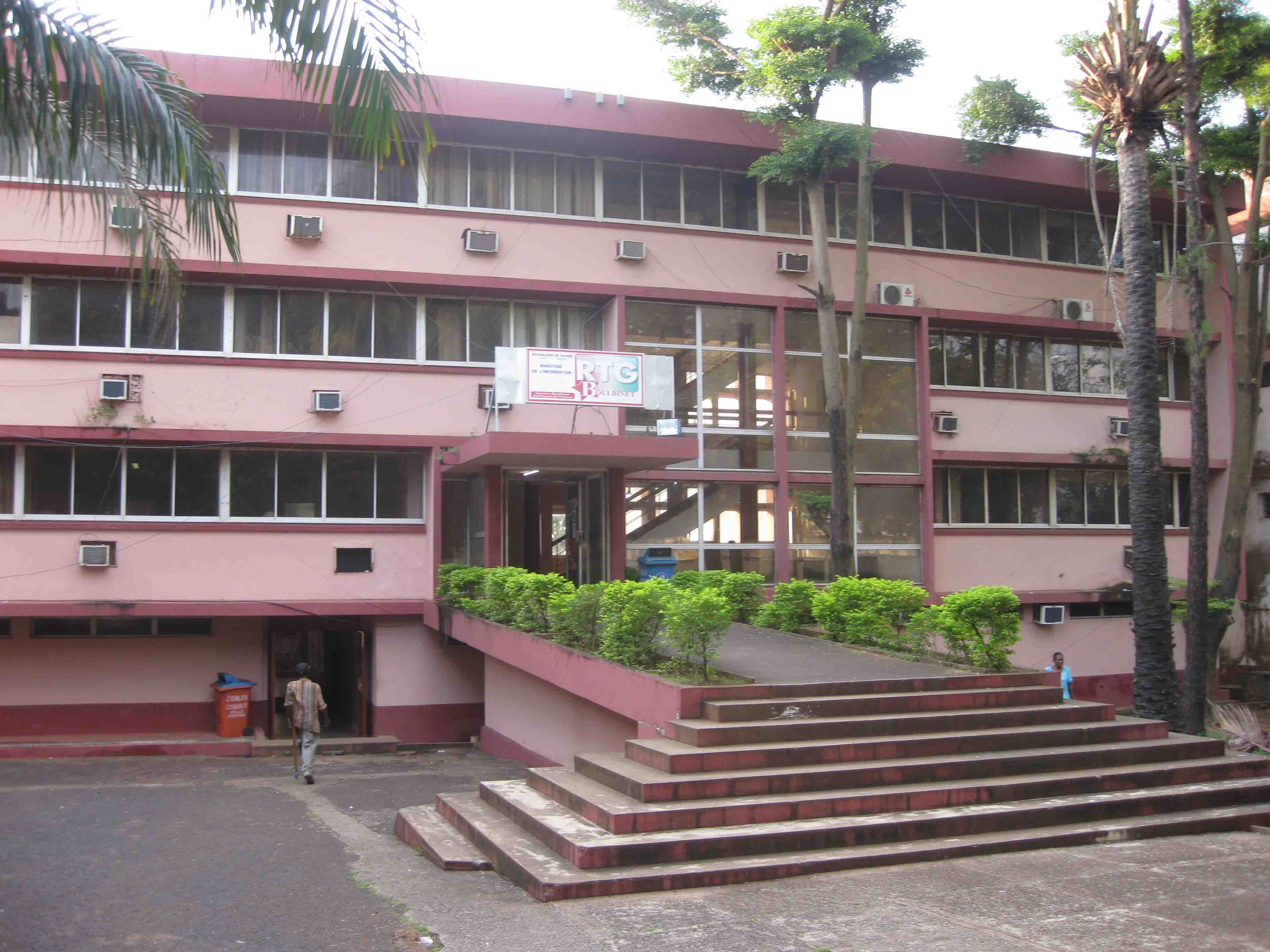
I commenced to preserve and digitise the
audio reels, focusing on the older recordings,
which included: 1963 recordings by the Orchestre Honoré Coppet
(an early member of the Syli Orchestre National); 1963
recordings by Orchestre de la Paillote; 1964 recordings by
the Orchestre de la Garde Républicaine 1ere formation; three
versions of a favourite song "Moi ça ma fout" (by Bembeya Jazz, Keletigui et ses
Tambourinis and Sombory Jazz); and recordings by excellent orchestres
federaux such as Manden Könö, Kébendo Jazz and Kaloum Star.
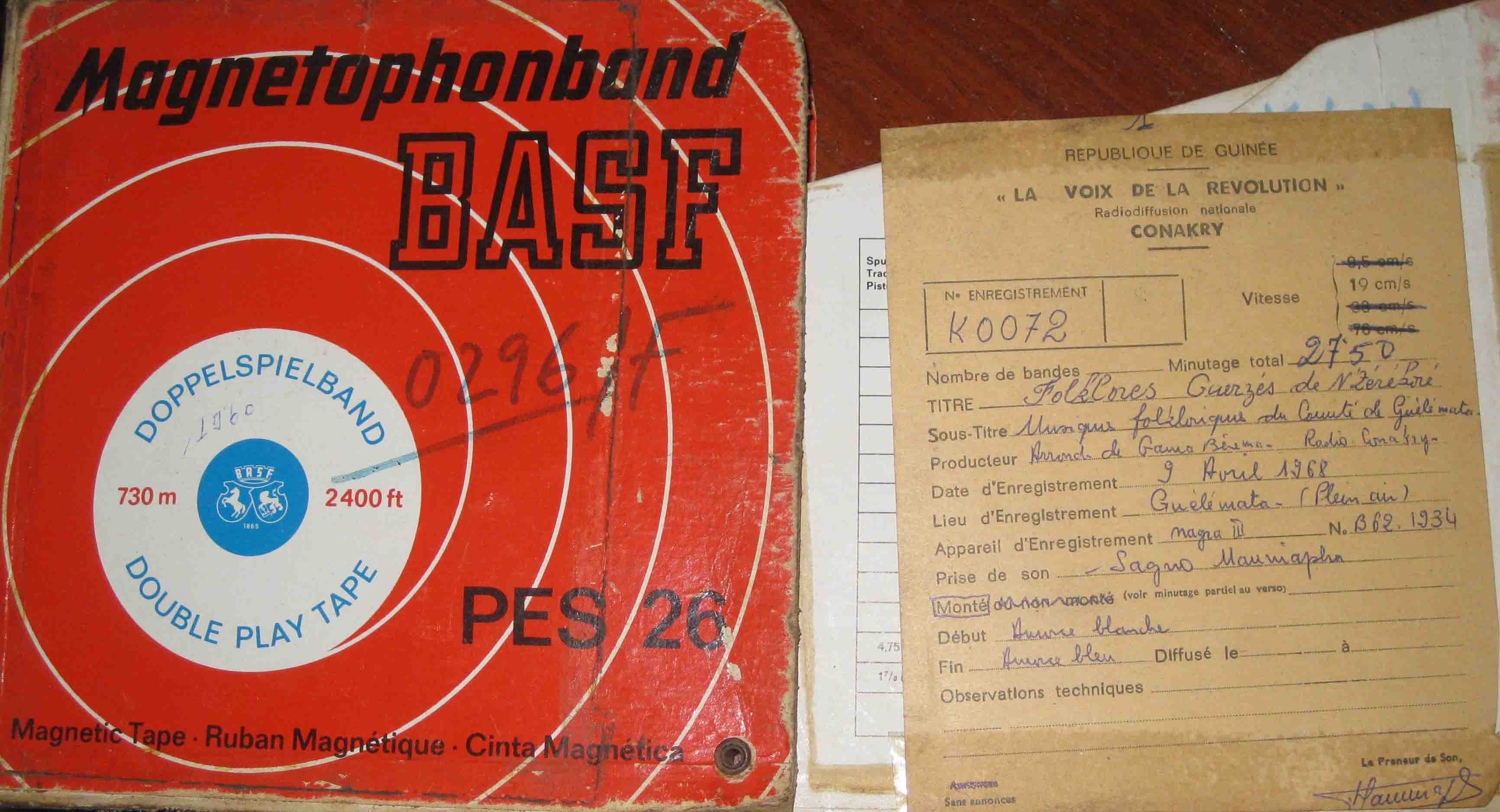
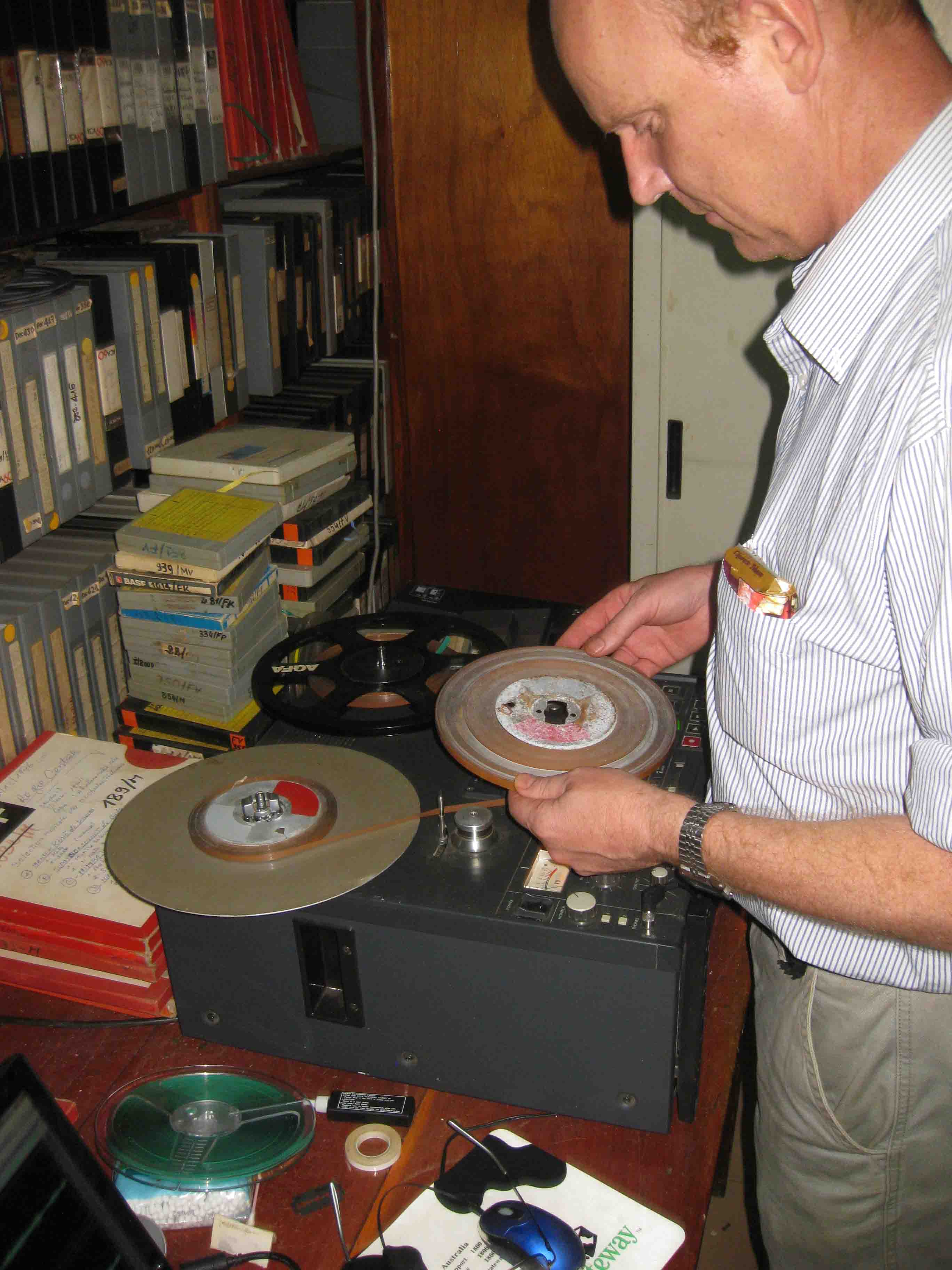
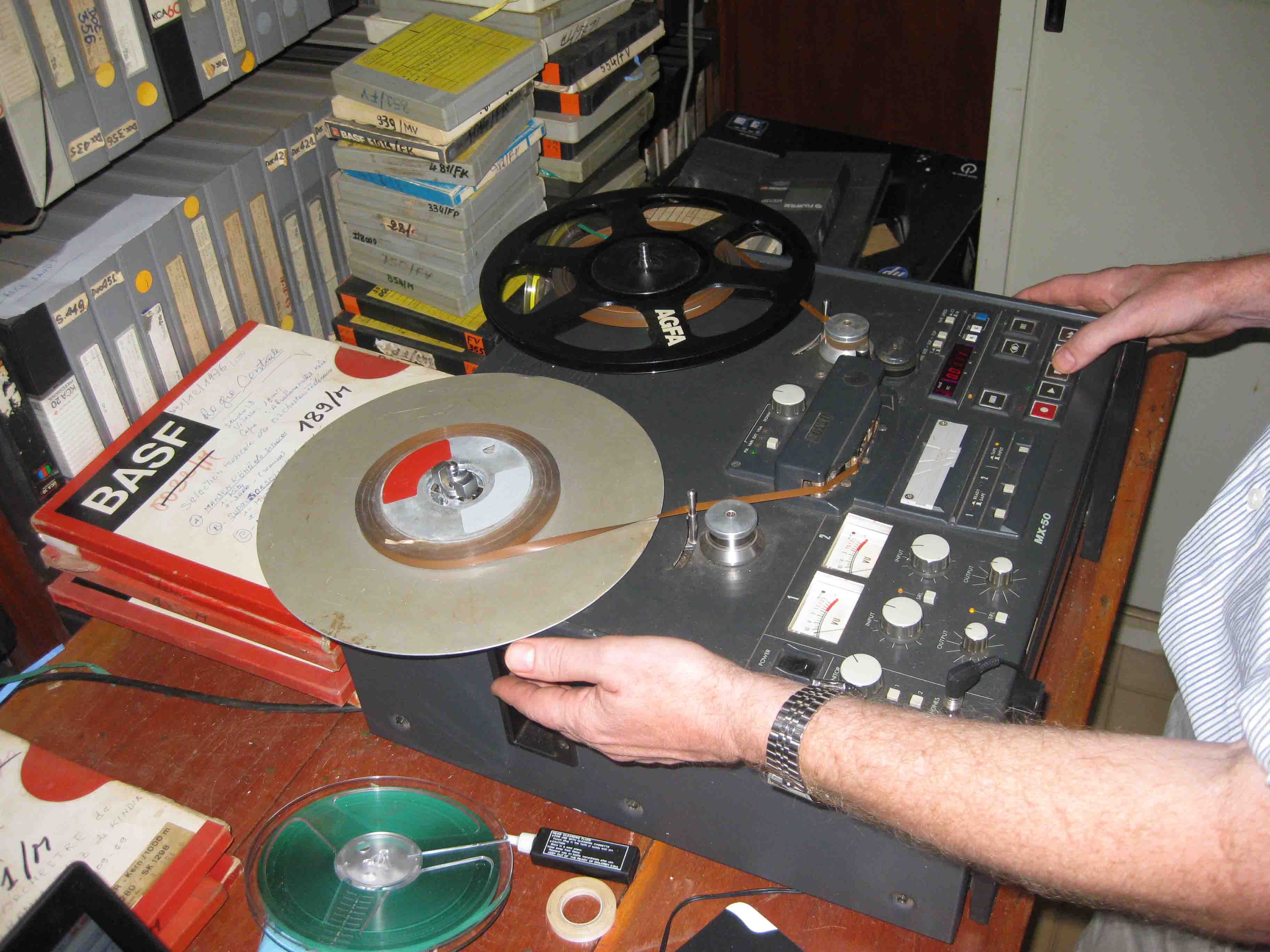
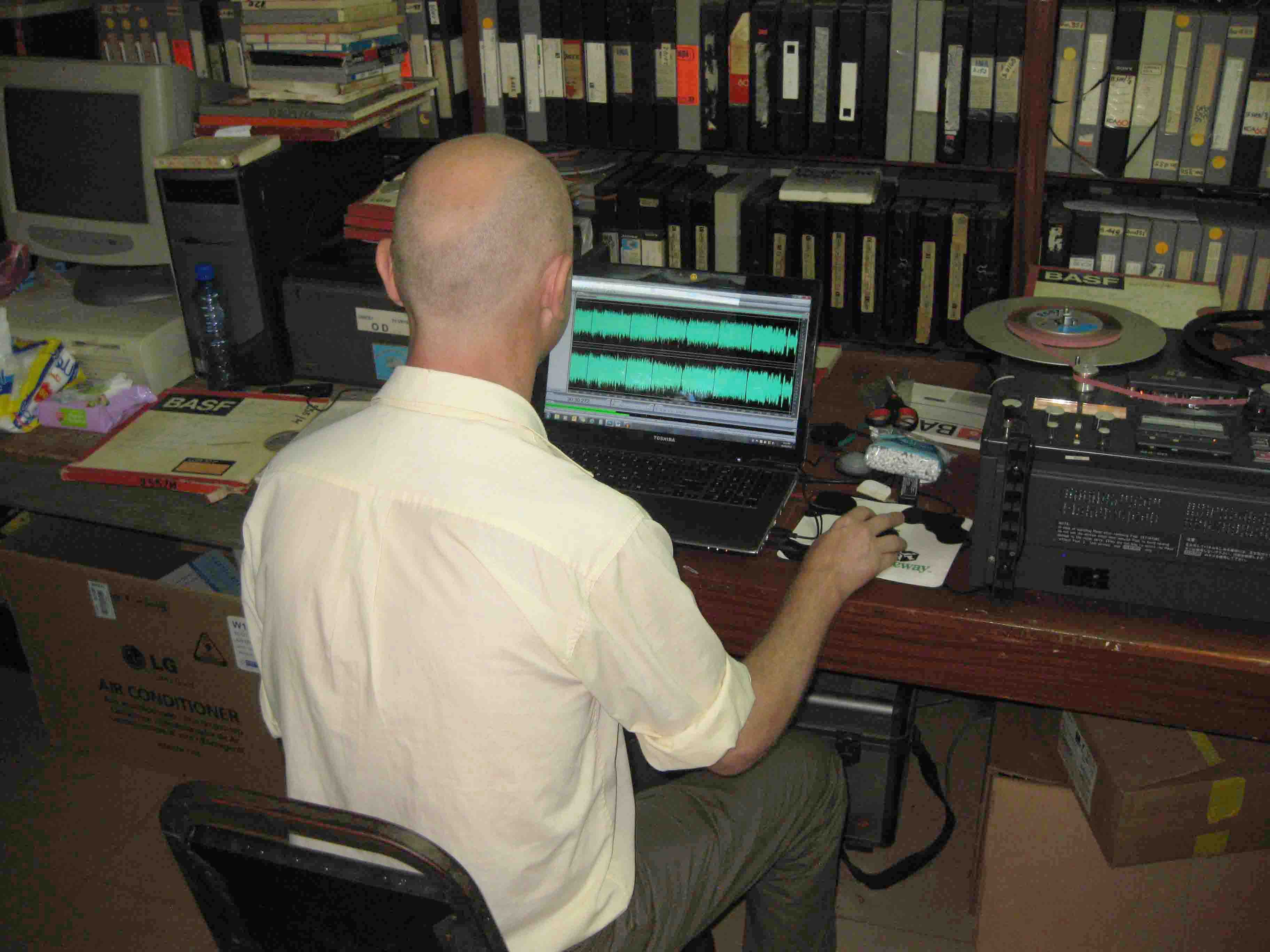
By late September 2008, the first part of my project - to recreate the complete Syliphone vinyl archive as a digital collection on compact disc - was close to completion. The CD collection would be permanently available at the Bibliothèque Nationale de Guinée, and its Director, Dr Sylla, along with the Culture Ministry, arranged for an official launch, an "exposition", to be held at Guinea's National Museum. Jean Baptiste Williams had contacted the media and arranged for the RTG to record a television commercial to advertise the archive launch. A camera crew arrived and filmed Dr Sylla and I miming "oohs" and "aahs" as we looked over the Syliphone vinyl discs that had been transferred to CD format. The RTG is Guinea's sole TV station, no advertisements, so the commercial drew a lot of attention! The launch was set for September 29.
I remember well the morning when I gave Dr Sylla the last of the Syliphone CDs transferred from vinyl, for it meant that the Syliphone collection was now complete - all 750 songs from the original 160 vinyl records had been digitised and transferred to compact disc. I had prepared three bound copies of the "Syliphone catalogue", which featured each Syliphone vinyl recording with its cover both recto and verso and its track listing. These were presented to Dr Sylla and the RTG. The National Library were also presented with four large framed pictures which featured many of Guinea's great musicians. The Syliphone catalogue of recordings is available at this website.
On the morning of the archive
launch, a huge thunderstorm arrived.
It rained very heavily.
"A good sign", someone
said. A crowd had gathered inside the museum
which included journalists,
Guinean musicians, the Imam of Conakry, public figures and friends. Dr Sylla opened the ceremony with a speech, followed by
my own,
and then Minister Iffono spoke to the assembled guests. General Facinet Touré, President Conté's right-hand
man and the former Minister of Foreign Affairs, closed the ceremony, and
at its conclusion he awarded me a Diplôme
d'Honneur. Highlights from the archive launch were broadcast on the RTG's
national news that night, and I was so
very happy that the project had been such an
amazing success.
I was also very moved by the heartfelt and sincere
thanks that were expressed: some
told me that when they had heard of the archival project they felt like crying
(such was the RTGs neglect over the decades), and several
were moved to tears during the launch. There was great joy that the complete
Syliphone catalogue had been restored, amidst the sadness of its neglect during the years
of President Conté's rule (1984-2008). I was even proclaimed "a Guinean",
a great honour indeed!, and was often asked how I managed to
assemble all of the Syliphone vinyl discs together and what led me to
this area of research. I could only respond that my 15 years of
collecting Syliphone recordings and
researching the history of modern Guinea was
indeed my passion, and that the music of the era were
an inspiration to me, and many.
The "Syliphone Archive" and its bound catalogue of vinyl recordings transferred to CD format were displayed at the National Museum for a week. The exposition was later re-launched for a further week in October 2008 as part of Guinea's 50th anniversary of independence celebrations.
Once the project of delivering the entire Syliphone catalogue of vinyl discs transferred to CDs was complete, I was able to leverage its momentum to commence the second part of the project. I was granted acces to the RTG sound archive to commence the digitisation and preservation of its vast collection of audio reels recorded on 1/4” magnetic tape . The collection was immense, there were literally thousands of songs to archive. It was an impossible task: the archive was too large and I had too little time remaining. In the few weeks that I had access to the RTG, the archival project successfully preserved and digitised 554 songs held on 69 reels of 1/4" audio tape. A great deal of work remained, and committed to return to complete the archival project.
Before departing Guinea,
I was informed that I would be receiving a medal for the work.
The Guinean government, through the Ministère de la Culture
des Arts et Loisirs, awarded me the gold medal of the Palme
Académique en Or, Guinea's highest academic honour. It had
never been awarded to a non-African citizen.

To my left is Dr Sylla, Directeur de la Bibliothèque Nationale de Guinée, and to my right is Dr Iffono, Ministre de la Culture des Arts et Loisirs.
I informed
the Guinean government that I was committed to
returning in 2009 to complete the archival
project. I successfully applied for
further funding
through
the Endangered Archives Programme, which
became known as the project EAP
327: "Guinea's Syliphone archives" (2009).
As of 2008, readers will be heartened to learn that the following orchestras continue to play regularly in Guinea: Bembeya Jazz National, Horoya Band National, Keletigui et ses Tambourinis, Balla et ses Balladins, the 22 Band and Camayenne Sofa, with the latter releasing a new CD in September 2008 to mark their 35th anniversary. Even some of the smaller groups in Guinea, such as Kolima Jazz, still get together occasionally, and up until a few years ago groups such as Tinkisso Jazz and the Forest Band were still playing.
On
November 11 2008, all of Guinea was saddened by the news that Keletigui Traoré had passed away. He was given a state funeral and was buried in the cemetery at Camayenne. He was a true musical super star, a legend of modern African music whose career dated to the pre-independence era. His influence on Guinean music is immeasurable. Many of Guinea's musicians from the golden era of the 1960s and 1970s are now very old, and from Kébendo Jazz, for example, there is only one surviving member. But there is happier news. Balla et ses Balladins now feature a young line-up, fully trained in the original repertoire, thus hopefully ensuring that the orchestra's music will find its roots in a new generation of musicians. And then there is Kombo Jazz, an excellent orchestra featuring many of the Syliphone era stars, who play together every week. Guinea's premier venue, La Paillote, has for the last 50 years hosted live music most nights of the week. Go there while you can, and if you're lucky you will sit under the stars on a Saturday night while Linké Condé, now blind, leads the Tambourinis orchestra with his sublime electric guitar.
For further reading on the subsequent
Endangered Archives Programme projects
to digitise the RTG's sound archive see EAP
327: "Guinea's Syliphone archives" (2009) and EAP
608: "Guinea's Syliphone archives II"
(2012-2013).
See also the complete catalogue of RTG recordings.
Readers may also be
interested in this publication:
"Music
for a revolution: The sound archives of Radio Télévision Guinée",
in From Dust to Digital: Ten Years of the Endangered
Archives Programme, Maja Kominko (ed). Cambridge: Open Book
Publishers, 2015, pp. 547-586. My other publications are listed
at this website,
here.